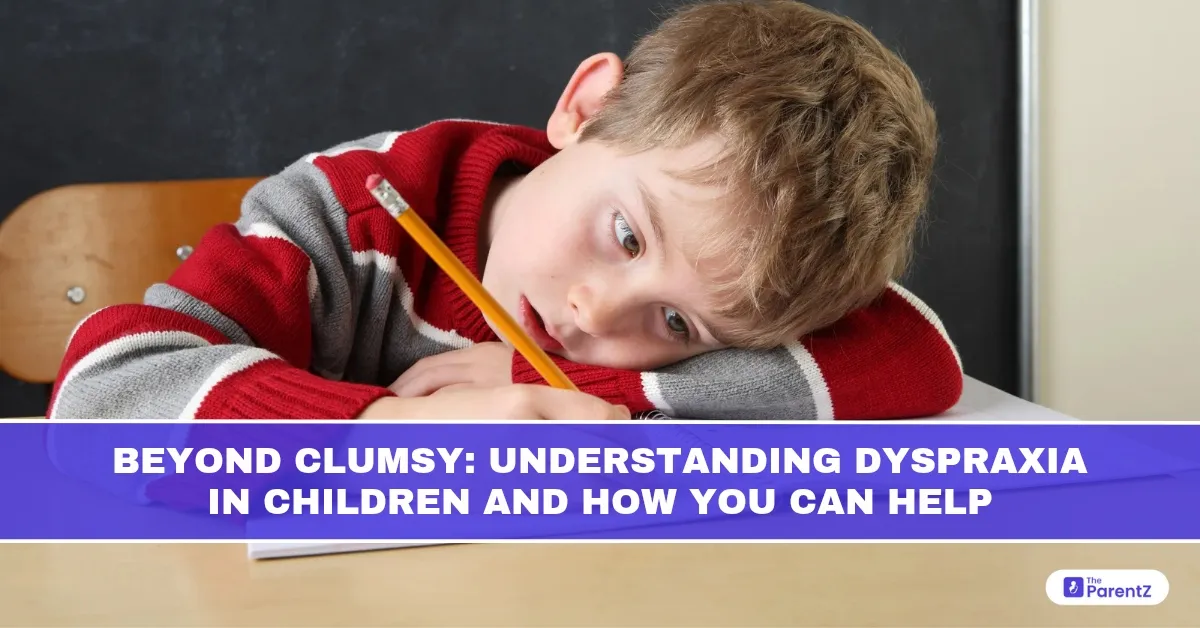More Than Just a Clumsy Phase
Every child trips, fumbles with zippers, or spills juice now and then; it’s all part of growing up. But what if your child seems especially uncoordinated? If they often struggle with tying shoelaces, holding a pencil, or even speaking clearly, it might be more than just typical clumsiness. It could be dyspraxia.
Also known as Developmental Coordination Disorder (DCD), dyspraxia is a neurological condition that affects motor planning—the brain’s ability to plan and carry out physical movements. Though it’s not as widely discussed as ADHD or autism, it can significantly affect a child’s daily life.
Let’s break down what dyspraxia looks like in children, how it can affect them emotionally and physically, and what parents can do to help.
What is Dyspraxia?
Dyspraxia is a neurodevelopmental condition that interferes with how children plan and execute movement. It’s not due to muscle weakness or intelligence issues, it’s about how the brain communicates with the body.
Think of it this way: your child knows what they want to do (zip up their jacket, ride a bike), but their body struggles to coordinate the steps smoothly. This difficulty can affect:
- Gross motor skills (running, jumping, catching a ball)
- Fine motor skills (writing, using scissors, buttoning)
- Speech and language
- Daily tasks like dressing or feeding
Early Signs and Symptoms in Children
Dyspraxia often becomes noticeable in early childhood, especially when children are expected to perform more coordinated tasks. Here are some signs to watch for:
Physical Clumsiness:
- Frequent tripping or bumping into things
- Difficulty learning to ride a bike or swim
- Trouble with skipping or jumping
Fine Motor Challenges:
- Struggles with handwriting or drawing
- Difficulty using utensils or tying shoelaces
- Slow or awkward dressing
Speech and Language Delays:
- Slurred or unclear speech
- Trouble forming complete sentences
- Difficulty finding the right words
Emotional and Social Clues:
- Frustration with tasks others do easily
- Low self-esteem or avoidance of physical play
- Difficulty making or keeping friends due to perceived “awkwardness”
These symptoms can overlap with other developmental issues like ADHD, autism, or sensory processing disorder. A professional assessment is key to understanding what’s really going on.
What Causes Dyspraxia?
The exact cause isn’t fully understood, but it’s believed to stem from disruptions in brain development before or shortly after birth. Risk factors include:
- Premature birth
- Low birth weight
- Family history of motor skill difficulties
- Early developmental delays
Dyspraxia is more common in boys and often runs in families. It’s important to remember that it’s not caused by laziness, bad parenting, or lack of practice; it’s a neurological condition.
How Dyspraxia Affects Everyday Life
Children with dyspraxia may:
- Be slower than peers in completing tasks
- Avoid sports or playground games
- Feel anxious about school assignments that require neat handwriting
- Get teased or excluded due to poor coordination
- Grow increasingly frustrated with themselves
This can lead to emotional fallout from tantrums in younger children to anxiety or low self-esteem in older ones. Without proper support, these feelings may spiral into academic challenges or social withdrawal.
Getting a Diagnosis
If you suspect dyspraxia, speak with your pediatrician, who may refer you to a:
- Pediatric neurologist
- Occupational therapist
- Developmental psychologist
Assessment typically includes:
- Observing motor skills in action
- Checking for delays in developmental milestones
- Ruling out other conditions
Early diagnosis means early intervention—and that can make a world of difference.
How to Help Your Child Thrive
The good news? With the right strategies, children with dyspraxia can learn to adapt, grow, and succeed. Here’s how parents can help:
1. Occupational Therapy (OT)
OT is the gold standard for dyspraxia. Therapists work on:
- Improving fine motor control
- Practicing daily tasks in small steps
- Teaching practical adaptations (like using thicker pencils or Velcro shoes)
2. Physical Therapy (PT)
PT can build strength, balance, and coordination. Therapists use fun, play-based methods to help kids master basic movements like hopping, balancing, or catching.
3. Speech and Language Therapy
If dyspraxia affects speech (called verbal dyspraxia or apraxia of speech), a speech therapist can guide your child through exercises to improve articulation and fluency.
4. Classroom Accommodations
Talk to your child’s teacher about:
- Extra time for writing or tests
- Allowing use of a keyboard or speech-to-text software
- Breaking tasks into smaller, more manageable steps
Some children may qualify for an Individualized Education Plan (IEP) or 504 Plan for support at school.
5. Emotional Support
Help your child recognize their strengths and validate their frustrations. Praise their efforts, not just the outcome. Enroll them in activities that play to their strengths, like music, drawing, or storytelling.
Day-to-Day Tips for Parents
- Keep routines predictable to reduce anxiety.
- Break down instructions into one- or two-step tasks.
- Use visual cues and demonstrations—show, don’t just tell.
- Celebrate small wins: mastering buttons, completing a puzzle, or saying a clear sentence deserves applause.
- Connect with support groups or other parents—you’re not alone.
Looking Ahead: Hope and Progress
While dyspraxia doesn’t “go away,” kids often develop coping skills and learn strategies that let them live full, active lives. With time and encouragement, your child can become confident in their abilities and proud of their progress.
Medical researchers are also exploring new therapies and better tools for early diagnosis, which may further ease the journey for families in the future.
Conclusion: From Clumsy to Capable
Dyspraxia may make your child’s road a little bumpier, but with your love and support, they can flourish. Remember, it’s not about fixing them, it’s about understanding their world and giving them tools to navigate it. Every stumble is a step forward, every tiny victory a triumph.
So, the next time your child spills the milk or fumbles with a shoelace, take a breath and remind them (and yourself) that progress takes time, patience, and a whole lot of heart.








Be the first one to comment on this story.